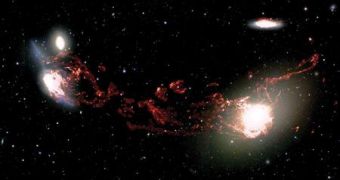Some gas tendrils between two galaxies indicate that a high-speed collision of the celestial bodies once took place. Scientists look up to this as a possible clue to the reason so many of the galaxies are unable to form new stars.
One of the two is the spiral galaxy NGC 4438 situated about 50 million light years away from us, within the Virgo galaxy cluster. It seems that the trails of gas in the region are far too hot in order for it to be able to get condensed up to a point where a new star may emerge from it. In fact, the galaxy's spiral arms even show too small levels of gas compared to those of other such galaxies. Scientists deduced that this might have been caused by a powerful crash and immediately began searching for the second cosmic victim. Initially, they thought that a proximal galaxy was involved, but, in fact, as it was eventually showed by Jeffrey Kenney and his colleagues from Yale University, they weren't right. Instead, the prolonged exposure of a wide portion of the shy NGC 4438 revealed a series of filaments of hydrogen gas that tied it to M86, an elliptical galaxy approximately 400.000 light years away. The gas is believed to have been ejected from one or both of them during the “accident”.
The 1.000 km/s Shockwave of the aftermath heated up M86's gas, which now makes the researchers believe this is the main reason elliptical galaxies can't form stars. Prior to that conclusion, they used to think that galaxies simply ran out of gas sources, but subsequent observations indicated that this is not the case, since a lot of gas had still been detected there. The conundrum that keeps pestering the scientific world is related to the explanation for the constant heating of the gas. An explanation of this phenomenon states that the gas from some galaxies is maintained hot by active galactic nuclei (AGN) which emit strong radiations after the matter is swallowed by enormous black holes. But since elliptical galaxies don't have AGN in their centers, experts blame the star formation-preventing heating process on such celestial crashes or on the activity of gas clouds accumulation.
They rely on future analyses of this impact in order to determine the percentage of the energy transformed into heat. According to Kenney, “It's the first case where there's evidence a collision might have heated the gas in an elliptical galaxy”.

 14 DAY TRIAL //
14 DAY TRIAL //